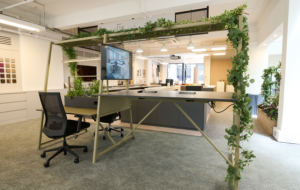|
|
||
|
“I have never called myself a fashion designer,” says Issey Miyake. It sounds like a contradiction from someone who has been designing clothes for 40 years and who built Japan’s most famous fashion brand in the process. So what is he? “I’m fascinated by all fields of design,” he says. “Design as an approach to society, people, life. Even if it looks like what I have done has become fashionable, fashion to me is like the wind, I like to stay constant. I put my mind to making a product that people enjoy.” Miyake’s approach to designing clothes is like that of a product designer. He isn’t preoccupied with mood boards and inspiration meetings. Instead the process entails a long period of research into materials, manufacturing techniques and a continuous dialogue between him and his team. Miyake’s garments are the fruits of collaboration. And once the Miyake Design Studio has found a formula that works, it stays constant, with only small changes from season to season. This is part of the popularity of lines like Pleats Please and A-POC Inside, revered by plump middle-aged women, curators and fashion hipsters alike. Now 72, the designer is launching a new line of clothes that can best be described as wearable origami: 132 5. Miyake looks a little tired as we sit down at a table in Galerie Kreo in Paris. His friends, Kreo owners Didier and Clemence Krzentowski, have lent him the space to showcase the new collection. The gallery is dominated by mannequins dressed in the ten different garments that make up the 132 5 collection; at their feet the same clothes lay flat and deflated, folded into beautiful patterns and stamped with metallic foils. If you tug at the corner of one of the shapes, the garment unfolds, reveals itself, and you can see how it takes on the outline of a skirt. There is no correlation between the flat shape and its 3D incarnation – it’s like pulling something from a magician’s hat. The name, 132 5, is apparently a play on this. It is derived from the process of one piece of cloth being given a 3D form, then being folded into a 2D plane, then being cut and transformed into a new piece of clothing. Miyake hardly ever gives interviews and icon is fortunate to get access to the ageing designer. He touches his forehead and admits, “My brain. It’s tired.” Then he breaks into warm laughter, which disarmingly punctuates the interview throughout. At the same time Miyake’s slight but handsome figure instils reverence in his entourage. There are two very tall assistants ever at the ready with all kinds of props – hair brushes, lint rollers and business card holders. The interaction is wordless, fascinating to observe.
credit Fujitsuka Mitsumasa Miyake is considered the father of Japanese fashion. Not only did he present a completely new way of approaching garment construction – flat shapes with few, if any, seams, which adjusted entirely to the wearer’s body – he also brought Japan from fashion obscurity to the very forefront of contemporary fashion design. Together with Kenzo Takada, Miyake came to Paris in the late 1960s, following in the footsteps of the older female couturier Hanae Mori. After a stint at Guy Laroche and Givenchy, he went to work with Geoffrey Beene in New York before returning to Japan in 1970 to set up his own label. Miyake turned his back on the classicism of French garment construction and instead applied Beene’s casual tailoring to the Japanese manufacturing system. It is here, on the cusp between east and west, that Miyake has built his empire, with 120 stores across the world, three clothing lines and a successful fragrance collection. The 132 5 project is his first sartorial venture since retiring from the main Issey Miyake line in 1999. It plays with the themes of his earlier work, drawing them to a culmination of sorts. Here the fashion atelier is replaced by the Reality Lab – a team of eight led by Miyake, Sachiko Yamamoto and Manabu Kikuchi. The famous pleats are replaced by folds and the mass manufactured by the handmade. Ever since Miyake started out he has valued visits to factories, and these visits were the starting point for 132 5. “There are so many designers that only work on computers,” says Miyake. “They don’t care to relate what they design to reality, but here we had to use touch and feel, all the five senses, when we went to the factory to talk to people. We could have tea together, we would talk and share experiences, so this project is based on human communication.” The project is born out of a desire to conserve what’s left of traditional Japanese textile manufacturing – Miyake is sad to see how few factories and workshops are left compared to when he started out. “This is a work of hope. The work of technicians, research people, and I want to show them that we can do it,” say Miyake and laughs again. “Like Obama.” Miyake has a compulsion to innovate and explore – this is part of the success of his brand and also why he continues to work. “I like to sleep, I like to rest a lot but at the same time, when I’ve got energy, I start again,” he says. And part of that activity has been to recast himself as a benefactor of design. “I never worked only for money, but I use the money from the perfume and I spend it on something for the people.” The biggest project to date since retiring has been 21_21 Design Sight, Japan’s first museum dedicated exclusively to design, which he set up in Tokyo with product designer Naoto Fukasawa, graphic designer Taku Satoh and writer Noriko Kawakami. Housed in a building partly submerged in the soil, designed by Tadao Ando, it opened to the public in 2007. For Miyake the project is a way of giving back to society and putting the money that the Issey Miyake brand has afforded him to good use, but one also suspects it has to do with leaving a legacy behind, one beyond the rag trade. “Being a designer of fashion is such a short destiny, but I want to last longer,” he says. Not knowing what to expect from an ageing designer with so many international accolades, it is refreshing how humble Miyake still is, always observing and willing to learn. He tells a story that seems typical of his personality. When he arrived in London in the 1960s, he called up Vidal Sassoon to ask if he could watch as they cut hair in the salon. “I was there for hours, looking at them cutting hair, it reminded me of the way a thatched roof is made.” After that he returned to London from Paris every two months to have his own hair cut at Vidal Sassoon. Miyake still has an impressive head of hair, greying and wavy. He also insists on a thin moustache, which I’m sure would look wrong on anyone else, but Miyake carries it with pride. The Vidal Sassoon experience clearly made a strong impression – one can see a parallel between that and the pleats in his collections. The pleated garments bounce around the wearer’s body just like Sassoon’s dead-straight haircuts bounced around the faces of his clients. Both have a sculptural quality that is determined by the person underneath. This could be what makes the 132 5 collection look a little clumsier than previous designs, the permanent folds creating a more rigid structure around the body, not as revealing. This idea of freedom runs as a thread throughout his work. In principle it fits all, regardless of shape or size. When he started out his career he set out to innovate around the universal jeans and T-shirt; even if Miyake’s later garments are more elegant than that ubiquitous cotton ensemble, the idea of universality remains. As such it manages to become the perfect hybrid of art and commerce. The collections may have a highly intellectual starting point, but they sell and sell: since the launch of Pleats Please in 1993, 2,500,000 garments have been made, a lot for something considered “designer clothing”. In comparison 132 5 is designed to be more exclusive. “We can’t sell too much because it’s done by hand, one by one,” says Miyake, who himself has folded some of the garments, before they are heat-pressed to achieve permanent folds. “But they keep taking it off me because I’m too slow.” Instead the freedom in this project is in the lightness of being, both on the wearer and on the environment – the fabric is made from PET and reused polyester fibres. “When I first tried it on a model, she said ‘I feel like I’m not wearing anything, because it’s just air inside’,” he explains. For the launch of 132 5 in November, Miyake has employed an architect with a similar interest in freedom and the immaterial to design the store: Sou Fujimoto. “I heard him speak about his idea of primitive futures at 21_21 and it made me curious, it made me want to work with him,” says Miyake. “It’s so boring to do something too ordinary. I like people who surprise me.” This hunt for novelty means Miyake counts some of the world’s most famous architects and designers as collaborators. Japanese designer Shiro Kuramata designed Issey Miyake’s first Tokyo store in 1976, in 1997 Italian designer Ettore Sottsass designed a perfume bottle for L’Eau D’Issey (launched 2009) and the French furniture designers Erwan and Ronan Bouroullec did the Paris A-POC store in 2000. Today, interactive designer Moritz Waldemeyer is in Paris to meet with Miyake for a future collaboration. Miyake’s curiosity brings these people to him – he never seems to be fully switched off, there is always a willingness to explore where these collaborations can take the brand and himself. In the case of 132 5, it was a blog post about software developed by Dr Jun Mitani, a computer scientist at the University of Tsukuba – which through a mathematical algorithm can create three-dimensional structures through the folding of flat paper – that started the creative juices flowing. But despite his proximity to some of contemporary design’s finest, Miyake claims not to collect design – but then reels off a list of designers he owns pieces by: “I have several of Shiro Kuramata’s pieces at home because he was a friend.” Ron Arad and the Bouroullecs’ designs “are used a lot in the office”. And his Paris apartment is decked out in former RCA graduates’ work. The Japanese ambassador to Paris is on his way – the assistants communicate in hushed voices and our interview has to be wrapped up quickly. Talk moves on to how to expand on the 132 5 collection. In one corner of the exhibition there is a range of paper lanterns that look like an evolution of Isamu Noguchi’s famous rice paper lamps. They are made from the traditional Japanese paper washi, mixed with the same PET that is used for the garments. The cordless lanterns are particularly attractive. It’s a project that the Reality Lab is doing in collaboration with Sharp and the finished result will reach stores next year. But what else? “It would be great to develop a medicine to make you younger,” says Miyake, and breaks into laughter again.
credit Fujitsuka Mitsumasa |
Image Milo Keller & Julien Gallico
Words Johanna Agerman Ross |
|
|
||
















